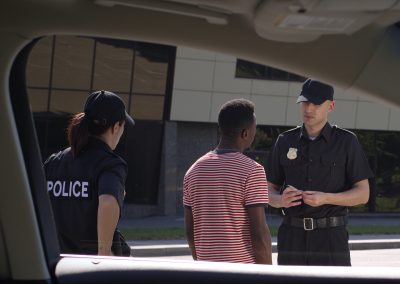It was a hot early evening in L.A. with no humidity or wind because before it was known as “L.A.” Los Angeles was a verified desert. Two patrolmen were doing what every good cop does on patrol: driving slow enough to see beyond the patrol car with some windows down to hear danger coming towards them or someone calling for help. It was 50 years ago this month, August 1965.
A California Highway Patrol motor officer stopped a vehicle that he suspected was driven by a drunk driver. During the investigation that followed, on one of the many typical suburban streets with multiplex apartment buildings lining the street, little did the motor officer anticipate that the outcome of him being positive and progressive in his duties would be ground zero for what would come to be known as the Watts Riot.
Two patrolmen from L.A.P.D.’s 77th division were conducting their patrol duties as they have done many times before when suddenly a crackling of the radio broke the momentary silence. “Officer needs assistance” sent them into a call they would remember for the rest of their lives. One of the L.A.P.D. officers was my dad, Officer Joseph F. Scanlon, Badge # 7735 …
Remember that in the academy you were taught to expect the unexpected with each call and to always get ready for the worst. If it’s less than what you anticipated then you most likely would handle the call effectively and with confidence. I believe the L.A.P.D officers had learned the same lesson, but even they didn’t know this call was going to make history.
As my dad and his partner arrived on the scene they saw a large crowd yelling and criminally inciting. The crowd was extremely animated, obviously defiant and angry. The CHP officers’ uniforms were ripped and the lawfully stopped car occupants were frightened. More assistance was needed to disperse the crowd and allow the CHP officers to keep their arrestees safe from the belligerent crowd, which began to throw glass bottles and concrete bricks at the officers. The officers were able to retreat from the immediate scene and CHP was able to keep their arrestees from harm. The mob eventually made it outside their immediate neighborhood and began stoning cars and busses, overturning cars and beating occupants of the listed vehicles.
During the six-day riot, many gun shop owners supported law enforcement efforts by providing short-supplied police with guns and ammunition.
History repeats itself, unless you‘re willing to change it. L.A.P.D., C.H.P and L.A.S.O. worked together for some of the evening to keep the unruly and criminal crowd from spilling into more neighborhoods beyond where the arrests took place. Remember there was no such thing as cell phones or Facebook then. There was only radio and print news, and so information came slowly by today’s standards.
The area officers continued to patrol and make arrests in and around the area of the original arrests and keep a lid on things. Several hundred officers were quickly made available for the effort, and they could easily call for mutual aid from a wealth of law enforcement agencies crisscrossing the region.
But just like today, the field sergeant at the scene attempted to educate his chain of command of the necessity for assistance and greater resources. But to no avail. This was a classic Gordon Graham “high-risk/low-frequency” event, but who was listening? Let me ask you a personal question: Does it sound familiar?
All of us need a history lesson. On the street we handle things quickly and as cleanly as we can, and we avoid what’s untidy and removed—like history. We avoid actions that would put us in the limelight and move on to the next incident …
Meanwhile outside commentators with no police training impugn the entire profession over examples that feel a world removed from our own. What‘s even more disturbing is when the criticism comes from within our own agency or agencies that are tasked with conducting an investigation into a particular incident.
Conclusion
The laws of this country and the clear decisions and authority from the U.S. Supreme Court, especially on vehicle pursuits and use of force, are sound and easy to follow and administer. You just need keep familiar with these issues and to be articulate and thorough with your reporting and evidence.
So, police leaders, here is your mission: Learn from the past and apply what works, get in front of the crowd and explain where explanation is needed. If you are uncertain of a particular aspect of an incident, I‘m sure someone within your organization will take care of you and provide you enough information to succeed. But most of all—support your crime fighters!











0 Comments